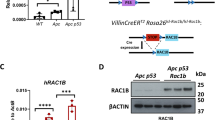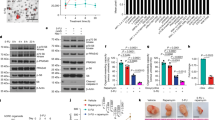Abstract
The role of deleted in colorectal carcinoma (DCC) as a tumour suppressor has been a matter of debate for the past 15 years. DCC gene expression is lost or markedly reduced in the majority of advanced colorectal cancers1 and, by functioning as a dependence receptor, DCC has been shown to induce apoptosis unless engaged by its ligand, netrin-1 (ref. 2). However, so far no animal model has supported the view that the DCC loss-of-function is causally implicated as predisposing to aggressive cancer development3. To investigate the role of DCC-induced apoptosis in the control of tumour progression, here we created a mouse model in which the pro-apoptotic activity of DCC is genetically silenced. Although the loss of DCC-induced apoptosis in this mouse model is not associated with a major disorganization of the intestines, it leads to spontaneous intestinal neoplasia at a relatively low frequency. Loss of DCC-induced apoptosis is also associated with an increase in the number and aggressiveness of intestinal tumours in a predisposing APC mutant context, resulting in the development of highly invasive adenocarcinomas. These results demonstrate that DCC functions as a tumour suppressor via its ability to trigger tumour cell apoptosis.
This is a preview of subscription content, access via your institution
Access options
Subscribe to this journal
Receive 51 print issues and online access
$199.00 per year
only $3.90 per issue
Buy this article
- Purchase on Springer Link
- Instant access to full article PDF
Prices may be subject to local taxes which are calculated during checkout



Similar content being viewed by others
References
Fearon, E. R. et al. Identification of a chromosome 18q gene that is altered in colorectal cancers. Science 247, 49–56 (1990)
Mehlen, P. et al. The DCC gene product induces apoptosis by a mechanism requiring receptor proteolysis. Nature 395, 801–804 (1998)
Fazeli, A. et al. Phenotype of mice lacking functional deleted in colorectal cancer (Dcc) gene. Nature 386, 796–804 (1997)
Fearon, E. R. & Vogelstein, B. A genetic model for colorectal tumorigenesis. Cell 61, 759–767 (1990)
Mehlen, P. & Fearon, E. R. Role of the dependence receptor DCC in colorectal cancer pathogenesis. J. Clin. Oncol. 22, 3420–3428 (2004)
Takaku, K. et al. Intestinal tumorigenesis in compound mutant mice of both Dpc4 (Smad4) and Apc genes. Cell 92, 645–656 (1998)
Roush, W. Putative cancer gene shows up in development instead. Science 276, 534–535 (1997)
Goldschneider, D. & Mehlen, P. Dependence receptors: a new paradigm in cell signaling and cancer therapy. Oncogene 29, 1865–1882 (2010)
Mazelin, L. et al. Netrin-1 controls colorectal tumorigenesis by regulating apoptosis. Nature 431, 80–84 (2004)
Forcet, C. et al. The dependence receptor DCC (deleted in colorectal cancer) defines an alternative mechanism for caspase activation. Proc. Natl Acad. Sci. USA 98, 3416–3421 (2001)
Li, W. et al. Activation of FAK and Src are receptor-proximal events required for netrin signaling. Nature Neurosci. 7, 1213–1221 (2004)
Forcet, C. et al. Netrin-1-mediated axon outgrowth requires deleted in colorectal cancer-dependent MAPK activation. Nature 417, 443–447 (2002)
Watson, A. J. et al. Epithelial barrier function in vivo is sustained despite gaps in epithelial layers. Gastroenterology 129, 902–912 (2005)
Kiesslich, R. et al. Identification of epithelial gaps in human small and large intestine by confocal endomicroscopy. Gastroenterology 133, 1769–1778 (2007)
Fodde, R. et al. A targeted chain-termination mutation in the mouse Apc gene results in multiple intestinal tumors. Proc. Natl Acad. Sci. USA 91, 8969–8973 (1994)
Boivin, G. P. et al. Pathology of mouse models of intestinal cancer: consensus report and recommendations. Gastroenterology 124, 762–777 (2003)
Ghoumari, A. M. et al. Implication of Bcl-2 and Caspase-3 in age-related Purkinje cell death in murine organotypic culture: an in vitro model to study apoptosis. Eur. J. Neurosci. 12, 2935–2949 (2000)
Bernet, A. et al. Inactivation of the UNC5C Netrin-1 receptor is associated with tumor progression in colorectal malignancies. Gastroenterology 133, 1840–1848 (2007)
Acknowledgements
We wish to thank D. E. Bredesen and J.-G. Delcros for critical reading of the manuscript. We thank C. H. Herbreteau and C. Bonod-Bidaud for their initial involvement in this work and the animal facility staff for animal care. We thank the ICS for the generation of the DCC mutant mice. We thank the LMT (Laboratoire des Modèles Tumoraux) and AniPath for the analysis of animal models. This work was supported by institutional grants from the Ligue Contre le Cancer, INCA, ANR, IP ApoSys and the LabEX DEVweCAN (ANR-10-LABX-61).
Author information
Authors and Affiliations
Contributions
M.C., L.B., Y.M., G.C., L.M., L.J.-W., A.B. and P.M. designed the experiments, the mice models and performed data analysis. M.C., L.B. and Y.M. performed most of the experiments. J.-Y.S., M.B., N.G. and A.P. performed pathological analysis of tumour grade and in vivo quantification of apoptosis. M.C. and P.M. wrote the manuscript. P.M. and A.B. are co-senior authors.
Corresponding author
Ethics declarations
Competing interests
The authors declare no competing financial interests.
Supplementary information
Supplementary Information
The file contains Supplementary Figures 1-3 with legends. (PDF 2030 kb)
Rights and permissions
About this article
Cite this article
Castets, M., Broutier, L., Molin, Y. et al. DCC constrains tumour progression via its dependence receptor activity. Nature 482, 534–537 (2012). https://doi.org/10.1038/nature10708
Received:
Accepted:
Published:
Issue Date:
DOI: https://doi.org/10.1038/nature10708
This article is cited by
-
The role of stromal cells in epithelial–mesenchymal plasticity and its therapeutic potential
Discover Oncology (2024)
-
DCC/netrin-1 regulates cell death in oligodendrocytes after brain injury
Cell Death & Differentiation (2023)
-
Somatic mutations in DCC are associated with genomic instability and favourable outcomes in melanoma patients treated with immune checkpoint inhibitors
British Journal of Cancer (2022)
-
The Ectodysplasin receptor EDAR acts as a tumor suppressor in melanoma by conditionally inducing cell death
Cell Death & Differentiation (2019)
-
Loss of Neogenin1 in human colorectal carcinoma cells causes a partial EMT and wound-healing response
Scientific Reports (2019)
Comments
By submitting a comment you agree to abide by our Terms and Community Guidelines. If you find something abusive or that does not comply with our terms or guidelines please flag it as inappropriate.



